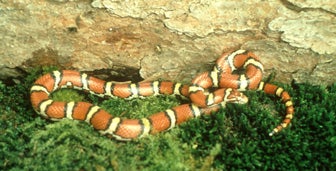SCIENTIFIC NAME:
Lampropeltis triangulum triangulum
STATUS:
Uncommon and infrequently encountered in eastern portions of Appalachian Plateau, including Lookout Mountain. Similar in habits and habitat preference to red milk snake, with which it intergrades westward in DeKalb and Jackson counties. MODERATE CONSERVATION CONCERN.
DESCRIPTON:
Eastern milk snakes (Lampropeltis triangulum triangulum) are medium sized snakes that range in total length from 24-52 inches. The dorsal (top) surface of these snakes typically is gray to tan in color with black bordered dark gray or brownish blotches (red in juveniles) down the back with similar smaller blotches on sides of the body. A light colored Y or V-shaped patch is present on the nape of the neck or the back of the head. The venter (belly) has rectangular black markings that often are arranged in a checkerboard fashion. Three subspecies of Lampropeltis triangulum occur in Alabama, L. triangulum elapsoides (Scarlet Kingsnake), L. triangulum triangulum (Eastern Milk Snake), and L. triangulum syspila (Red Milk Snake).
DISTRIBUTION:
The northern borders of L. triangulum triangulum’s rangein North America include southeastern Maine, southwestern Quebec, southeastern and south central Ontario, southern Wisconsin, central and southeastern Minnesota, northeastern Iowa, the northern half of Illinois, and most of Iowa. It’s range extends southward on the east coast to northern New Jersey then runs down through the Appalachian Mountains to northern Georgia and Alabama and westward through Kentucky into western Tennessee. In Alabama, L. triangulum triangulum has been documented in the Lookout Mountain region of Dekalb County in the extreme northeastern region of the state. Intergrades between L. triangulum syspila and L. triangulum triangulum have been found in Dekalb and Jackson Counties.
HABITAT:
Eastern milk snakes are found in diverse habitat settings which include coastal bottomlands, mixed pine-hardwood uplands, meadows, rocky outcrops, sand dunes, farmland, and suburban areas. They seek shelter in rocky outcrops, under logs or boards, and in other protected sites. Specimens have been located in or near rocky outcrops in the northeastern mountainous regions of Alabama.
FEEDING HABITS:
Eastern milk snakes are known to feed on a variety of small rodents, birds, lizards, and snakes.
LIFE HISTORY AND ECOLOGY:
Information on L. triangulum triangulum in Alabama is limited. The species is secretive and seldom encountered. It mates in the spring and deposits an average of seven or eight elliptical-shaped eggs in rotting logs. The incubation period is six to nine weeks. Young range from approximately 5-11 inches in length.
CONSERVATION STATUS:
Moderate Conservation Concern in Alabama.
REFERENCES:
“Milk Snake”, Online Field Guides. eNature.com.
Mount, R.. 1975. The Reptiles & Amphibians of Alabama. Auburn Printing Co., Auburn, AL. 347 pp.
AUTHOR:
Steve Barnett, Wildlife Biologist, Alabama Division of Wildlife and Freshwater Fisheries






